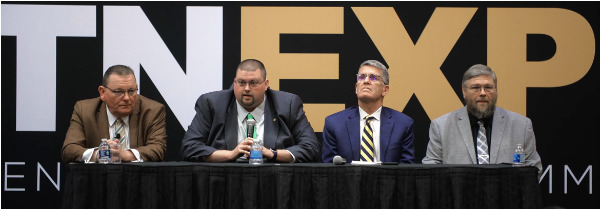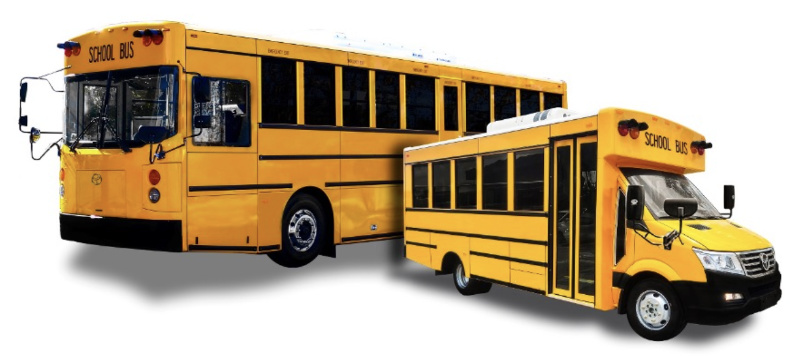South Charleston, West Virginia, September 26, 2023 – GreenPower Motor Company Inc. (NASDAQ: GP) (TSXV: GPV) (“GreenPower”), a leading manufacturer and distributor of purpose-built, all-electric, zero-emission medium and heavy-duty vehicles serving the cargo and delivery market, shuttle and transit space and school bus sector, recently announced the results from its successful all-electric school bus pilot program conducted in West Virginia that resulted in subsequent all-electric school bus orders. GreenPower shared its findings along with helpful data to improve future deployments at the Green Bus Summit held during STN EXPO in Reno, Nevada this summer.
“The GreenPower all-electric school buses did what they were supposed to do throughout the entire pilot. The buses transported the kids to school in the morning, home safely at night, and in some cases, on to football games or other extracurricular activities,” GreenPower Vice President of Business Development and Strategy Mark Nestlen said in releasing the program results. “There was no case where the buses failed to perform nor meet the demands of the school districts and drivers.”
As a result of the successful pilot program and the performance of the GreenPower vehicles, schools in the Mountain State have placed orders to purchase GreenPower all-electric, purpose-built school buses to deploy in their fleets, and have also asked to receive GreenPower school buses purchased by the state. Several of the pilot program counties have applied for new funding through the EPA and other sources to purchase additional GreenPower school buses as well.
Joining GreenPower in presenting the key findings of the pilot program were Delegate Christopher Toney, a school bus driver in Raleigh County (WV) who is also the Vice Chairman of the West Virginia House of Delegates Committee on Education; Dr. Tom Williams, Superintendent of the Kanawha County (WV) School District; and Dr. Barry Miller, a bus driver for the Calhoun County (WV) School District. Watch the panel presentation at STN EXPO’s Green Bus Summit.

“If it can work in West Virginia, it can work in your state,” said Toney. “We were not easy on it. We didn’t cherry pick a route that it went on either. We told drivers and counties to put it on routes where it was going to be put to the test. We showed it can work.”
The nine-month pilot program covered more than 32,000 miles in 18 counties representing one-third of the school districts in the state. More than 100 professional school bus drivers drove the GreenPower Type D BEAST and Type A Nano BEAST during the pilot and provided feedback and recommendations at the conclusion of each round.
“It was overall a good experience. For the most part our drivers liked the bus. They loved the braking; they loved the turning radius of the bus,” stated Williams. “Our kids thoroughly enjoyed the quiet, smooth ride and no diesel smell along with the technology aspect. The mechanics appreciated it. It’s very, very low maintenance. It was just a good experience for our county and we ended up purchasing a GreenPower all-electric BEAST school bus.”
Each participating school district piloted either the Type D BEAST or the Type A Nano BEAST purpose-built, all-electric school bus for six weeks between September 2022 and May 2023, covering the entire school year, multiple seasons and some of the harshest weather and terrain the Mountain State has to offer.
“The vehicles in this pilot were put through the ringer, facing weather ranging from single digit temperatures to mid-80s, with some days starting in the teens and ending in the 50s,” said Fraser Atkinson, CEO of GreenPower. “They weathered sun, rain, ice and snow while successfully navigating mountainous roads with up to 9% grades. The vehicles, both the BEAST and Nano BEAST, managed, without incident, West Virginia’s famously difficult to navigate roads – often having to traverse gravel, dirt and one-lane roads.”
“The BEAST handle as good, or even better, than a conventional diesel school bus. It made every turn and climbed every hill the same as a diesel, doing everything we asked it to do,” Miller added. Reflecting on the first time driving the GreenPower bus, he said, “I drove it and I’m like this is the best driving vehicle I’ve ever had. I believe my exact words when I got in, put it in gear, and put my foot on the pedal was ‘wow’! It just went with no hesitation. You put your foot down and it goes.”
Key findings from the pilot project included:
- In ideal conditions, the range for the all-electric school buses was 1.4 to 1.5 miles per one percent charge, or 140 to 150 miles on a full charge. On one occasion, a BEAST achieved 1.67 miles per one percent charge, or 167 miles total range. Another high performance saw a BEAST go 147 total miles that include 9% inclines on mountainous roads on a 15-degree day while returning with 7% battery remaining.
- School districts participating in the pilot were able to demonstrate significant operational savings over a fleet of standard diesel-fueled buses. One participating district, Boone County, took into account the recorded difference in just fuel costs – $200 a month in electricity vs. $900 a month in diesel fuel – which would translate into fuel savings of $136,000 over 10 years. In reality and practice the total savings for an all-electric school bus is much greater when including all operational and maintenance cost savings.
- Aggressive usage of heat reduces the range. The data shows that aggressive use of heat on extremely cold mornings reduced the range in some cases by more than 30%. Conversely, air conditioning use did not show a material impact on range.
- Changes in elevation did not significantly affect the vehicle’s range. While uphill driving will deplete the battery faster than flat terrain, downhill segments restore energy to the battery through regenerative braking so the two tend to average out. One county, Grant County, experienced a net zero energy use over a 17-mile stretch going up and down from Mt. Storm.
- Driver habits affect the range just like it does gas mileage in a personal car.
- All vehicles were charged with temporary Level 2 chargers provided by a number of vendors. While Level 2 charging proved to be largely adequate for this pilot, cold weather and other conditions suggested DC Fast Charging is necessary as a context-based option. Reporting software proved to be critical in instances where any charging interruptions took place overnight. The software provided notifications when power surges or other disruptions occurred, allowing them to be recycled in a timely manner so the problem would not be long term.
“What this pilot showed was that GreenPower all-electric, purpose-built school buses will do what students, parents and administrators need and want them to do. Charging and charging infrastructure needs to be considered on a case-by-case basis. It is not just a question of is a Level 2 or DC fast charger needed, but fundamentally understanding the scenario, context and needs of the school district is essential to determining the best charging solution,” continued Atkinson. “The results of the pilot allows us to work with school districts using proven data to find the solution that will fit their needs best.”
Toney stated that the pilot shows the buses worked in West Virginia and will work elsewhere. “We put the buses to the test. We showed people that it can work. If you have the infrastructure, if you have the knowledge and training, it can work and it works in our state.”
Nestlen concluded that the pilot answered the questions of how far does the bus go, how long does it take to charge it and what infrastructure is necessary for charging. “It answered those questions in a way that can be used anywhere in the country to help school districts make education decisions on how to deploy all-electric school buses in their fleets,” he said.
Contacts
Mark Nestlen
Vice President of Business Development & Strategy
mark.n@greenpowermotor.com
Michael Perez
Vice President of School Bus, Contracts and Grants
michael@greenpowermotor.com
Allie Potter
Skyya PR for GreenPower
(218) 766-8856
allie@skyya.com
About GreenPower Motor Company, Inc.
GreenPower designs, builds and distributes a full suite of high-floor and low-floor all-electric medium and heavy-duty vehicles, including transit buses, school buses, shuttles, cargo vans and a cab and chassis. GreenPower employs a clean-sheet design to manufacture all-electric vehicles that are purpose-built to be battery powered with zero emissions while integrating global suppliers for key components. This OEM platform allows GreenPower to meet the specifications of various operators while providing standard parts for ease of maintenance and accessibility for warranty requirements. GreenPower was founded in Vancouver, Canada with primary operational facilities in southern California. Listed on the Toronto exchange since November 2015, GreenPower completed its U.S. IPO and NASDAQ listing in August 2020. For further information go to www.greenpowermotor.com.
Forward-Looking Statements
This document contains forward-looking statements relating to, among other things, GreenPower’s business and operations and the environment in which it operates, which are based on GreenPower’s operations, estimates, forecasts and projections. Forward-looking statements are not based on historical facts, but rather on current expectations and projections about future events and are therefore subject to risks and uncertainties which could cause actual results to differ materially from the future results expressed or implied by the forward-looking statements. These statements generally can be identified by the use of forward-looking words such as “upon”, “may”, “should”, “will”, “could”, “intend”, “estimate”, “plan”, “anticipate”, “expect”, “believe” or “continue”, or the negative thereof or similar variations. These statements are not guarantees of future performance and involve risks and uncertainties that are difficult to predict. A number of important factors including those set forth in other public filings (filed under the Company’s profile on www.sedar.com) could cause actual outcomes and results to differ materially from those expressed in these forward-looking statements. Consequently, readers should not place any undue reliance on such forward-looking statements. In addition, these forward-looking statements relate to the date on which they are made. GreenPower disclaims any intention or obligation to update or revise any forward-looking statements whether as a result of new information, future events or otherwise.
Neither the TSX Venture Exchange nor its Regulation Services Provider (as that term is defined in the policies of the TSX Venture Exchange) accepts responsibility for the adequacy or accuracy of this release. All amounts are in U.S. Dollars ©2023 GreenPower Motor Company Inc. All rights reserved.



